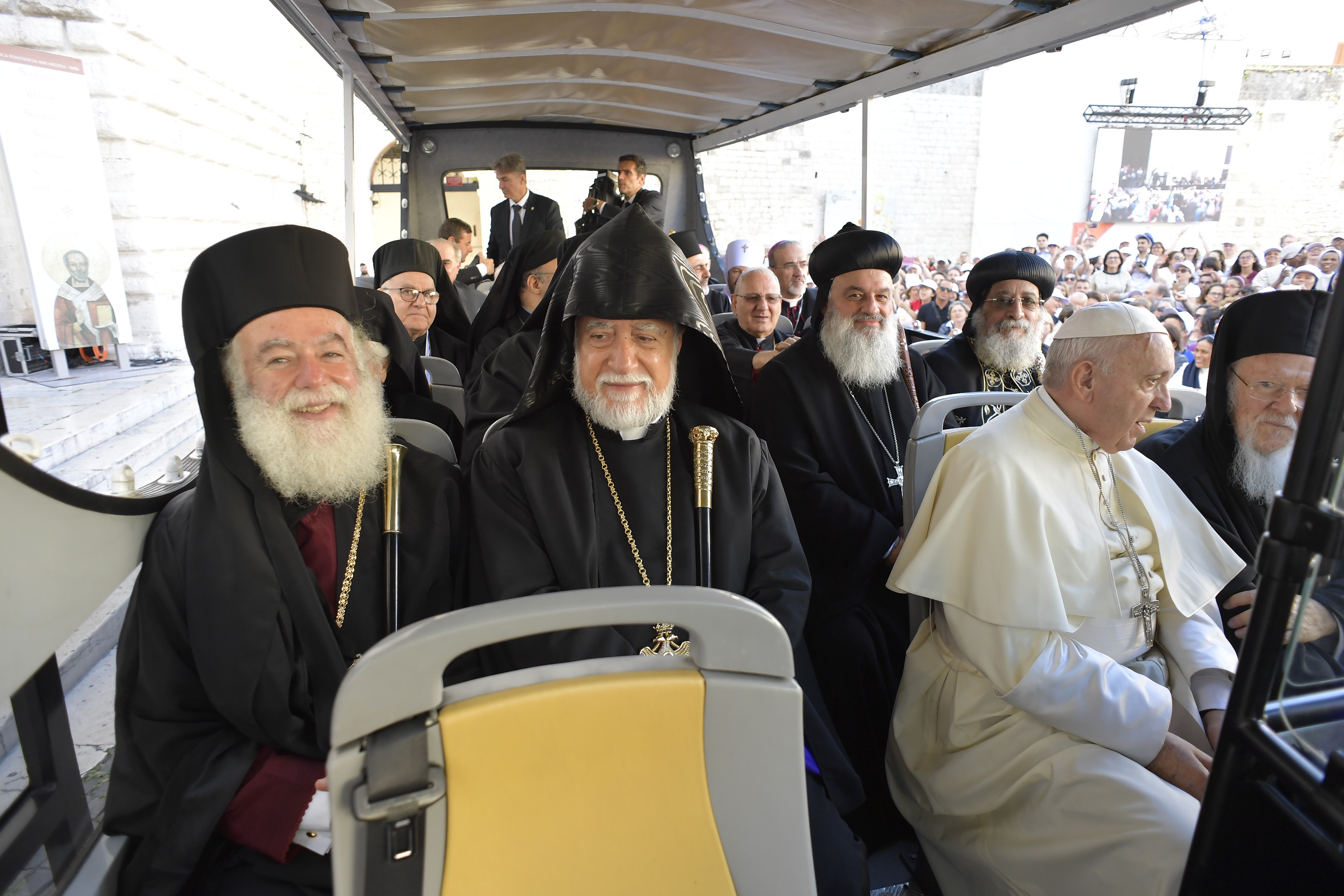Pope Francis has denounced murderous indifference toward the tragedies that have struck the Middle East, and rallied together in the southern Italian city of Bari with Christian leaders of the Middle East in an unprecedented initiative. But why was Bari chosen? Perhaps not everyone knows that in Bari, ecumenism, isn’t just an idea, but it is its reality, and this all traces back to St. Nicholas…
Zenit was on the ground and wants to give our readers an inside look.

Bari, Pope and Patriarchs – Copyright: Vatican Media
Not only because the basilica is a step away from the sea, inside the walls of “Old Bari,” the city’s oldest and most picturesque district. And, not only because it’s a genuine masterpiece of the renowned Apulian Romanesque, to which so many other churches of the Middle Ages refer, erected in the surroundings of Bari.

 Saint Nicholas’ Basilica is a tangible sign of unity — although still imperfect — between Catholics and Orthodox. The single flame that shines on the Saint’s tomb was lit together on February 26, 1984, by Saint John Paul II, who was visiting Bari, and Metropolitan Konstantinidis of Myrachrysostomos. In addition, the basilica is a unique case in the world for another reason: the crypt in fact also houses an Orthodox Chapel, demonstrating Bari’s welcome to all pilgrims of the East, especially Russians, who constitute more than half of the latter.
Saint Nicholas’ Basilica is a tangible sign of unity — although still imperfect — between Catholics and Orthodox. The single flame that shines on the Saint’s tomb was lit together on February 26, 1984, by Saint John Paul II, who was visiting Bari, and Metropolitan Konstantinidis of Myrachrysostomos. In addition, the basilica is a unique case in the world for another reason: the crypt in fact also houses an Orthodox Chapel, demonstrating Bari’s welcome to all pilgrims of the East, especially Russians, who constitute more than half of the latter.
Photo of Greg Burke, Vatican Press Office Director
Since ancient times, Saint Nicholas has been one of the most venerated Saints of Christianity. However, his origins weren’t in Puglia, the Italian region on the geographical map corresponding to the heel of the boot. He was born at Patara, in Asia Minor, around the year 260, and went a few years later to the neighboring city of Mira.

There aren’t many documented details on his life. Because of the works of mercy and charity he carried out from his youth, he was elected Bishop of Mira by popular acclamation. According to some sources, he took part in the Council of Nicea in 325, shortly before his death. Numerous are the miracles and prodigies that a rich biographical tradition attribute to him, witnessing that devotion that was paid to him immediately after his death, first at Mira and in neighboring cities, and later in all the Slavo-Byzantine area, up to the regions of southern Italy, then under Byzantium.

In front of the Basilica of St. Nicholas: Photo by Zenit’s Vatican Correspondent Deborah Castellano Lubov
 invocation to “happy Bari, which received this Saint of the East to also sanctify the West.”
invocation to “happy Bari, which received this Saint of the East to also sanctify the West.”This Italian city, the main one in the region of Puglia, has become, thanks to Saint Nicholas, a bridge between East and West: every year it welcomes thousands of Orthodox pilgrims from Russia, the Balkans and Greece. However, Saint Nicholas’ fame has also reached northern Europe, albeit in the guise of a particular personage, Santa Klaus, our Santa Claus. There is a popular legend, at whose origins is a noted episode of Nicholas’ life, mentioned also in Dante’s Divine Comedy, to marry off three poor youths Saint Nicholas gave them some gold coins. It’s said that, to not be discovered, the Saint threw the coins on the road, which slipped into the youths’ socks that were hanging out to dry.

Copyright: Vatican Media
And this ardent desire of Christian unity at Bari is not only done in prayer. It’s also a joint effort of study, research and reflection on the immense patrimony of history and culture that Eastern and Western Christianity share. There is an Ecumenical Theological Institute also dedicated to Saint Nicholas, where with effort, but also with trust, possible ways are sought to reduce the distances and re-establish fraternal bonds.

Copyright: Vatican Media
From this city yesterday, all these Christian leaders expressed their concern for the Middle East.
Ahead of a prayer meeting in the morning, the Pope warned in his address: «There is also the danger that the presence of our brothers and sisters in the faith will disappear, disfiguring the very face of the region.»
The Pope reiterated: «A Middle East without Christians is no longer the Middle East.»
«Indifference kills,» he said, «and we desire to lift up our voices in opposition to this murderous indifference. We want to give a voice to those who have none, to those who can only wipe away their tears.»

Closed Door Dialogue: Copyright: Vatican Media

Copyright: Vatican Media
In his final speech of the day, before returning to Rome, the Pope said off the cuff: «War is the scourge that tragically assails this beloved region. Poor people are the victims above all. Think of battered Syria… There, bitter fighting resumed, causing a huge number of displaced people, exposing them to terrible suffering.»
Pope Francis also appealed for the children affected by all this, and said «they must not be forgotten!»
***
On Zenit’s Web page:
Full Text of Pope’s speech before prayer meeting: https://zenit.org/articles/pope-in-bari-a-middle-east-without-christians-would-not-be-the-middle-east/
Full Text of Second Discourse: https://zenit.org/articles/pope-in-bari-hope-has-the-face-of-children/



